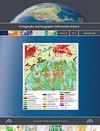为基于自然资源分类的地图图例开发可靠可区分的配色方案
IF 2.4
3区 地球科学
Q1 GEOGRAPHY
Cartography and Geographic Information Science
Pub Date : 2021-09-03
DOI:10.1080/15230406.2021.1942218
引用次数: 2
摘要
摘要基于自然资源分类的地图(如土壤、地质、地貌、植被和土地覆盖/土地利用)的图例需要许多不同的可区分颜色。现有的地图图例颜色选择方法是基于设计者的主观性,确保方案的颜色很少。通过对数字应用中颜色建模和管理的分析,定义了一种基于感知均匀颜色模型CIELAB计算色差客观色度测量值“DE*ab”的算法。所提出的方法包括一组用于开发分层结构配色方案的特定规则和一个用于确保基于色差阈值选择大量可靠可区分颜色的特定过程。印刷过程中色彩再现的准确性也被考虑在内。该方法已被应用于制定土壤地图的颜色标准。它包含63种颜色,并已用于开发具有41种标准颜色的土壤地图。该方法结果的用户测试证明,10个DE*ab单元和15个DE*ab单元的阈值分别确保通过使用高质量的当前设备来获得可接受的可区分颜色,用于显示/打印地图。给出了支持该研究的三个数据集。本文章由计算机程序翻译,如有差异,请以英文原文为准。
Developing reliably distinguishable color schemes for legends of natural resource taxonomy-based maps
ABSTRACT The legends of natural resource taxonomy-based maps (e.g. soil, geological, geomorphological, vegetation, and land cover/land use) need many different distinguishable colors. The existing methods of color selection for map legends are based on the designer subjectivity, ensuring schemes having few colors. An analysis of the modeling and management of colors in digital applications has led to define an algorithm to calculate an objective colorimetric measure of color difference – “DE*ab ” – based on the perceptually uniform color model CIELAB. The proposed method consists of a set of specific rules for developing hierarchically structured color schemes and a specific procedure for ensuring selection of a large number of reliably distinguishable colors, based on a color difference threshold. The accuracy of color reproduction in printing processes is also taken into account. The method has been applied to develop a standard of colors for soil maps. It contains 63 colors and has been used for developing a soil map having 41 standard colors. A user test of the method results proved that thresholds of 10 DE*ab units and 15 DE*ab units ensure obtaining acceptably distinguishable colors for displaying/printing maps by using high-quality, respectively, current devices. Three datasets that support the research are given.
求助全文
通过发布文献求助,成功后即可免费获取论文全文。
去求助
来源期刊
CiteScore
5.20
自引率
20.00%
发文量
23
期刊介绍:
Cartography and Geographic Information Science (CaGIS) is the official publication of the Cartography and Geographic Information Society (CaGIS), a member organization of the American Congress on Surveying and Mapping (ACSM). The Cartography and Geographic Information Society supports research, education, and practices that improve the understanding, creation, analysis, and use of maps and geographic information. The society serves as a forum for the exchange of original concepts, techniques, approaches, and experiences by those who design, implement, and use geospatial technologies through the publication of authoritative articles and international papers.

 求助内容:
求助内容: 应助结果提醒方式:
应助结果提醒方式:


